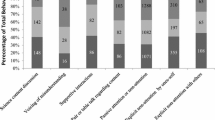Abstract
Previous research on the Clark-Trow model has failed to provide evidence on whether students classified into the same Clark-Trow subgroup interact with one another or are even aware of their common orientation. Yet, this is a basic tenet of claims that these subgroups operate as campus subcultures. This study investigated whether students who self-select into the same Clark-Trow subgroup interact significantly more often with each other than they do with members of the other three subgroups. The results tend to disconfirm expectations based on the Clark-Trow model and suggest these subgroups do not operate as student subcultures.
Similar content being viewed by others
References
Apostal, R. A. Student subcultures and personal values.Journal of College Student Personnel 1968,9 34–39.
Bolton, C., and Kammeyer, K. C. W. Campus culture, role orientations and social types. In Kenneth Feldman (Eds.),College and student. New York: Pergamon Press, 1972.
Brainard, S. R., and Dollar, R. J. Personality characteristics of leaders identifying with different student subcultures.Journal of College Student Personnel 1971,12 200–203.
Clark, B. R., and Trow, M.Determinants of college student subcultures. University of California, Berkeley: Center for the Study of Higher Education, 1960.
Feldman, K. A., and Newcomb, T. M.The impact of college on students (Vol. 1). San Francisco: Jossey-Bass, 1969.
Frantz, T. T. An investigation of college student subcultures (Doctoral dissertation, The University of Iowa, 1967).Dissertation Abstracts International, 1968,28, 2984-A. (University Microfilms No. 68-00927).
Hays, W.Statistics. New York: Holt, Rinehart, and Winston, 1972.
Kees, D. A study of college student subcultures using a typology (Doctoral dissertation, Washington State University, 1967).Dissertation Abstracts International, 1968,29, 2985-A. (University Microfilms No. 68-703).
Kees, D. The Clark-Trow typology revisited.Journal of College Student Personnel 1974,15 140–143.
Kees, D. J., and McDougall, W. P. A validation study of the Clark-Trow college subculture typology.Journal of College Student Personnel 1971,12 193–199.
Lange, A. An analysis of Clark-Trow subtypes.Journal of College Student Personnel 1972,13 347–351.
Lange, A., Woodburn, L. T., and Miller, W. G. OPI differences among Clark-Trow subgroups.Journal of College Student Personnel 1974,15 498–501.
Maw, I. E. L. Student subcultures and activity involvement.Journal of College Student Personnel 1971,12 62–66.
Ozaki, R. H. A comparative study of student subcultures and value systems in three state-supported institutions of higher education in Georgia (Doctoral dissertation, University of Georgia, 1971).Dissertation Abstracts International, 1972,32, 3699-A. (University Microfilms No. 72-2524).
Pascarella, E. T., and Terenzini, P. T. Personality correlates of Clark-Trow orientations toward college; a construct validation.Journal of College Student Personnel 1977,18 268–275.
Peterson, R. E.On a typology of college students. Research Bulletin 65-9. Princeton: Educational Testing Service, 1965.
Stern, G. G.People in context: measuring person-environment congruence in education and industry. New York: John Wiley, 1970.
Terenzini, P. T., and Pascarella, E. T. An assessment of the construct validity of the Clark-Trow typology of college student subcultures.American Educational Research Journal 1977,14 225–248.
Walker, J. R. A study of selected psychosocial correlates of college students (Doctoral dissertation, Oklahoma State University, 1967).Dissertation Abstracts International, 1968,29, 4883-A. (University Microfilms No. 68-8516).
Warren, J. R. Student perceptions of college subcultures.American Educational Research Journal 1968,5 213–232.
Williams, G. D. Clark-Trow viewpoints: associated personality traits and changes during the freshman year.Journal of College Student Personnel 1972,13 341–346.
Yinger, J. M. Contraculture and subculture.American Sociological Review 1960,25 625–635.
Author information
Authors and Affiliations
Rights and permissions
About this article
Cite this article
Hutcheson, S.M., Chapman, D.W. Patterns of student interaction in Clark-Trow subgroups. Res High Educ 11, 233–247 (1979). https://doi.org/10.1007/BF00975127
Issue Date:
DOI: https://doi.org/10.1007/BF00975127




